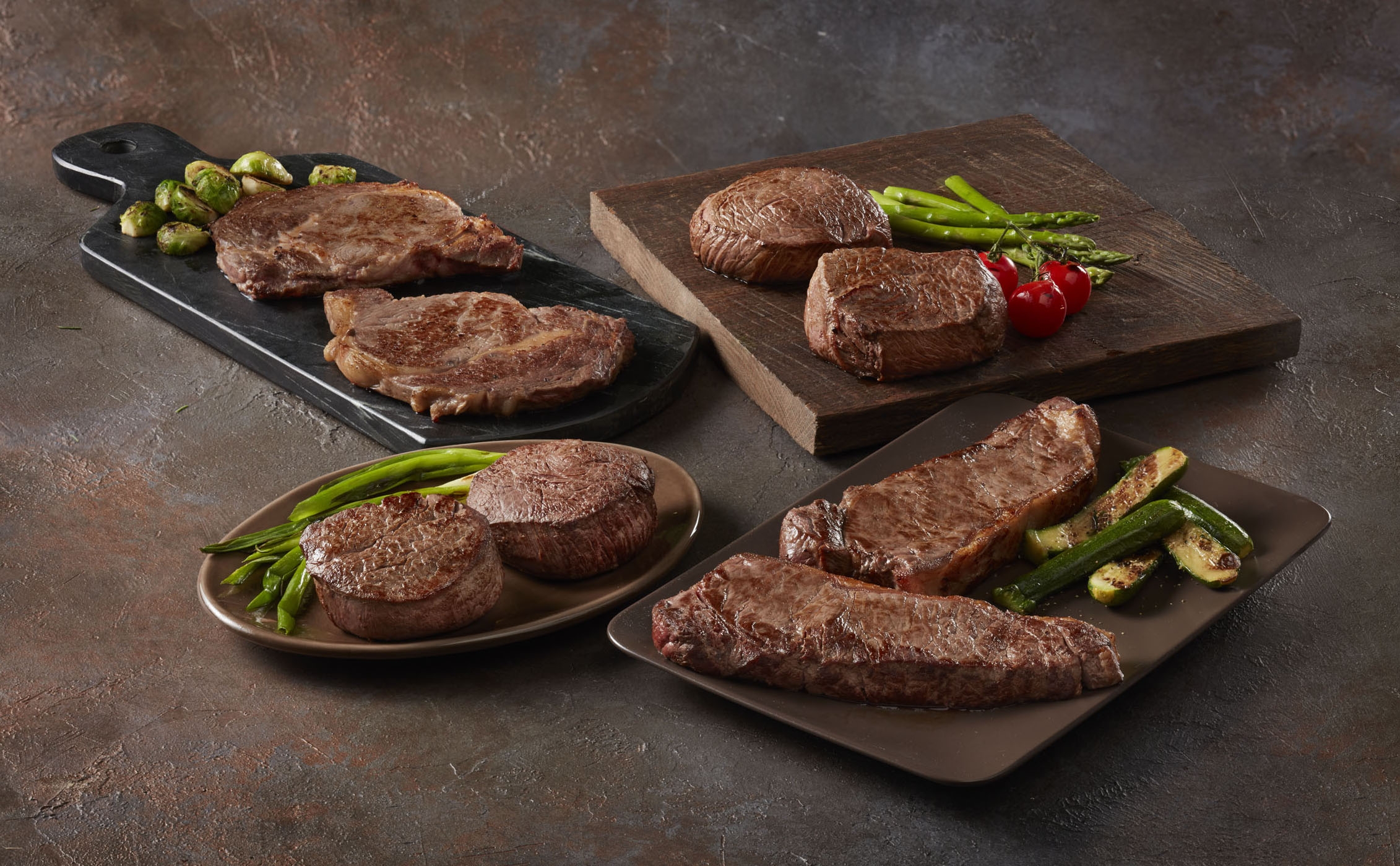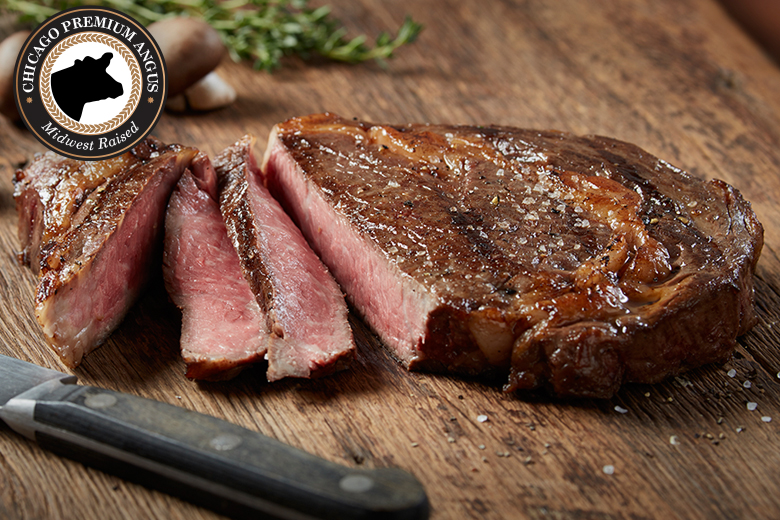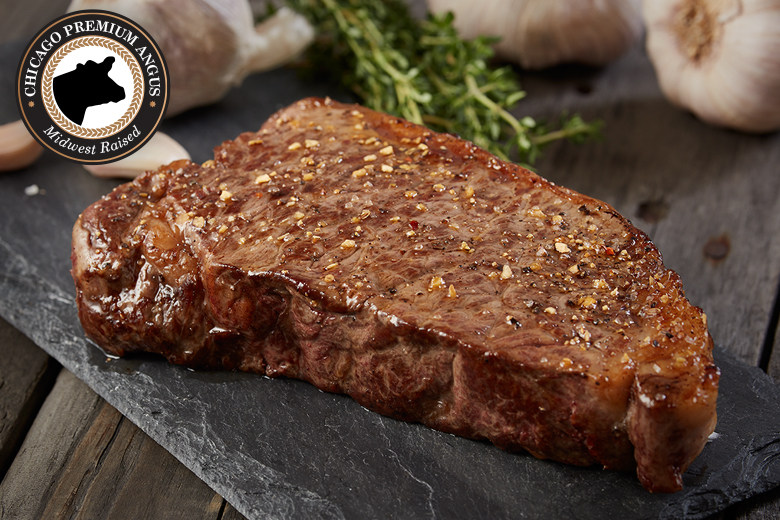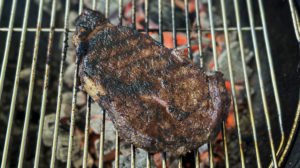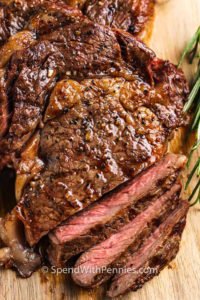Disclaimer: There are affiliate links in this post. At no cost to you, I get commissions for purchases made through links in this post.
Cut of steak refers to the specific portion or section of beef that is sliced and prepared for consumption. Steaks are highly prized for their tenderness, juiciness, and rich flavor, making them one of the most popular choices in meat-based cuisine. The tenderness and taste of a steak can vary greatly depending on the cut and its location on the animal.
There are numerous cuts of steak, each with its unique characteristics and culinary applications. Some of the most well-known cuts include the tenderloin (filet mignon), ribeye, New York strip, sirloin, T-bone, and porterhouse. Each cut comes from different parts of the cow, and factors like muscle usage and fat content play a significant role in determining their tenderness and taste.
Cooking methods, such as grilling, pan-searing, or broiling, are often employed to enhance the natural flavors and textures of steaks. Additionally, many people enjoy steaks with various accompaniments, such as sauces, vegetables, and potatoes, to create a delicious and satisfying meal.
Whether you prefer a lean and mild-tasting filet mignon or a well-marbled and robust ribeye, understanding the different cuts of steak can help you choose the perfect option to suit your palate and culinary preferences.
What cut of steak is the best?
The “best” cut of steak is subjective and largely depends on personal preferences, as different cuts offer varying levels of tenderness, flavor, and marbling. Each cut has its own unique qualities and is preferred by different people for different reasons. Here are a few popular cuts of steak and their characteristics:
- Filet Mignon: Often considered the most tender cut, the filet mignon comes from the tenderloin section of the cow. It has a mild flavor and is prized for its buttery texture. However, it may have less marbling compared to other cuts, which can affect its overall flavor.
- Ribeye: The ribeye is known for its rich, juicy, and flavorful taste. It comes from the rib section and typically has generous marbling throughout the meat, which adds to its succulence and robustness.
- New York Strip (also called striploin or sirloin strip): This cut is flavorful and moderately tender, coming from the short loin of the cow. It has good marbling and a nice balance of tenderness and beefy taste.
- T-Bone and Porterhouse: These cuts include both the tenderloin and the New York strip separated by a T-shaped bone. The tenderloin side is milder and more tender, while the strip side offers a heartier flavor. The porterhouse has a larger portion of the tenderloin compared to the T-bone.
Ultimately, the best cut of steak is the one that suits your personal taste preferences. If you enjoy a tender and mild steak, filet mignon might be your top choice. If you prefer a more flavorful and juicy experience, a well-marbled ribeye could be the best fit. Exploring different cuts and experimenting with cooking methods can help you discover your favorite steak. Additionally, the grade of the meat and how it is prepared can also significantly influence the overall enjoyment of the steak.
What is the best and tenderest cut of steak?
The best and tenderest cut of steak is often considered to be the Filet Mignon. Filet Mignon comes from the tenderloin, a muscle located in the short loin of the cow. This particular muscle does very little work during the animal’s life, resulting in a cut of meat that is incredibly tender.
Key characteristics of Filet Mignon that make it highly prized:
- Tender Texture: Filet Mignon is exceptionally tender, with a melt-in-your-mouth quality. Its soft and delicate texture is due to the lack of connective tissue in the tenderloin muscle.
- Minimal Marbling: While marbling (intramuscular fat) contributes to the flavor and juiciness of many steaks, Filet Mignon has less marbling compared to other cuts. As a result, it has a milder taste and a leaner profile.
- Mild Flavor: Filet Mignon has a subtle, almost buttery flavor, making it an excellent choice for those who prefer a less intense beef taste.
- Versatility: This cut is versatile and can be prepared in various ways, such as grilling, pan-searing, or even wrapping it in bacon for added richness.
While Filet Mignon is widely regarded for its tenderness, it’s essential to note that tenderness is just one aspect of a steak’s overall appeal. Some people might prefer the more robust flavor of other cuts like Ribeye or New York Strip, which have higher marbling and slightly more chew. The “best” steak ultimately depends on individual taste preferences, cooking styles, and culinary applications. Regardless, Filet Mignon remains a top choice for those seeking an incredibly tender and delicate steak experience.
What’s the best steak in the world?
The notion of the “best” steak in the world is highly subjective and can vary depending on individual tastes and preferences. Different regions and countries have their own unique breeds of cattle, rearing practices, and culinary traditions that contribute to the diversity of steaks available worldwide.
Some renowned types of steak enjoyed by meat connoisseurs include:
- Kobe Beef (Japan): Kobe beef is sourced from Wagyu cattle raised in the Kobe region of Japan. These cattle are known for their high marbling, resulting in an exceptionally tender and flavorful steak. Kobe beef is highly regarded but also quite rare and expensive.
- Matsusaka Beef (Japan): Another premium Japanese beef, Matsusaka, is highly prized for its marbling and rich flavor. The cattle are raised in Mie Prefecture and are given specialized diets and care.
- Black Angus (United States): Black Angus beef, particularly from USDA Prime or Choice grades, is well-known for its marbling, tenderness, and robust flavor. It is a popular choice in high-end steakhouses.
- Chateaubriand (France): Chateaubriand is a thick, tender steak cut from the center of the beef tenderloin. It is often associated with French cuisine and is known for its melt-in-your-mouth texture.
- Argentinean Beef: Argentina is famous for its high-quality grass-fed beef, particularly from breeds like Hereford and Angus. The cattle graze on lush pastures, resulting in beef with a distinct flavor.
Ultimately, the “best” steak is a matter of personal preference. Some people may prefer the rich marbling of Japanese Wagyu, while others may enjoy the robust flavor of a well-aged USDA Prime ribeye. Different cuts, preparation methods, and personal tastes all contribute to the enjoyment of a steak. For an individual, the best steak is the one that satisfies their specific palate and provides a delightful dining experience.
Where can you find the best cut of steak?
Finding the best cut of steak involves a combination of factors, including the quality of the meat, the skill of the chef or cook preparing it, and personal preferences. Here are some places where you might find a high-quality, well-prepared cut of steak:
- High-End Steakhouses: Upscale steakhouses often pride themselves on offering premium cuts of meat sourced from reputable suppliers. These establishments usually provide various cuts, aging options, and cooking styles to cater to different preferences. Chefs at high-end steakhouses are well-trained in preparing steaks to perfection.
- Specialty Butcher Shops: Look for specialty butcher shops that focus on high-quality meats. Knowledgeable butchers can guide you in choosing the best cuts for your preferences and provide custom cuts to suit your needs.
- Online Retailers: Some online meat retailers specialize in delivering high-quality steaks directly to your doorstep. Look for reputable companies with positive customer reviews and a selection of premium cuts.
- Local Farms or Ranches: If you have access to local farms or ranches that raise and sell their own beef, you might find some excellent, locally sourced steaks. Some farmers offer premium and well-cared-for cattle, resulting in top-quality meat.
- Trusted Grocery Stores: Some upscale grocery stores and specialty food markets carry premium cuts of meat, including prime-grade steaks. Look for trusted brands and inquire about the beef’s grade and source.
- Restaurants with Excellent Reviews: Research restaurants in your area known for their exceptional steaks. Read reviews and ask for recommendations from friends or online communities to find places that consistently serve high-quality steaks.
Ultimately, the best cut of steak is a matter of personal preference, and the ideal place to find it will depend on your location, budget, and the experience you are seeking. When looking for the best cut of steak, consider the grade of the beef, the cooking methods used, and the reputation of the establishment or supplier. Remember that the same cut can taste different depending on how it is cooked and seasoned, so be open to trying different preparations to find what suits your taste best.
Review about Chicago Steak Company
Chicago Steak Company has a rich history and commitment to providing high-quality American meats. With three generations of experience, they pride themselves on carrying on the legacy of Chicago’s tradition in the meat industry.
Their focus on hand-cut, mid-west raised, USDA Prime beef showcases their dedication to offering the very best steaks money can buy. The fact that they specialize in the top 2% of beef in the US (USDA Prime) speaks to their commitment to delivering premium-quality meat to their customers.
The use of centuries-old techniques in raising, trimming, and aging their steaks further emphasizes their dedication to tradition and quality. Vacuum-sealing each steak individually ensures that the flavor and freshness are preserved until it reaches the customer’s doorstep.
The unique registration number for each order adds a level of personalization and attention to detail. This attention to individual orders demonstrates their commitment to providing a top-notch experience to each customer.
The company’s association with some of the best white tablecloth steakhouses across the country and the recognition on the Discovery Science Channel highlights their reputation as a provider of high-end, luxury steaks.
Winning the Great Steak debate with Iron Chef Marc Forgione further showcases the quality and excellence of their products, garnering recognition from esteemed culinary experts.
Overall, the Chicago Steak Company seems to deliver on its promise of offering premium, hand-cut steaks with a strong emphasis on tradition and quality. The combination of their historical legacy, generations of experience, and focus on top-grade beef makes them a reliable option for those seeking the finest cuts of steak available in the market.
Which steak has the best flavor?
The steak with the best flavor is a matter of personal preference, as taste is subjective and can vary from person to person. Different steak cuts offer distinct flavor profiles due to variations in marbling, fat content, and muscle usage. Some people may prefer a more robust and beefy taste, while others might enjoy a milder and buttery flavor. Here are a few popular steak cuts known for their unique flavors:
- Ribeye: Ribeye steaks are highly regarded for their exceptional flavor. They have abundant marbling throughout, which contributes to their rich, juicy, and well-rounded beefy taste. The fat content in a ribeye enhances its flavor and tenderness, making it a favorite among many steak enthusiasts.
- New York Strip: The New York strip is also praised for its delicious beefy flavor. It has a good amount of marbling, offering a balance of tenderness and robust taste. The strip steak’s flavor profile is slightly more intense than that of the filet mignon, making it appealing to those who enjoy a heartier steak.
- Filet Mignon: While the filet mignon is known for its tender, melt-in-your-mouth texture, its flavor is milder compared to some other cuts. It has less marbling than ribeye or New York strip steaks, which results in a delicate and subtle beef flavor.
- Tomahawk Steak: The tomahawk steak, a ribeye with an extended bone, offers a combination of the ribeye’s rich flavor and the added complexity imparted by the bone. The bone can contribute a unique essence to the meat, enhancing the overall taste.
- Flank Steak: Flank steak has a bold, beefy flavor and can be quite tasty when properly marinated and cooked. It is often used in various international dishes, like fajitas and Asian stir-fries, where its flavor is appreciated.
Ultimately, the best-tasting steak for you will depend on your personal preferences and culinary tastes. Experimenting with different cuts and cooking methods can help you discover which steak aligns best with your palate and provides the most enjoyable dining experience.
Is sirloin or ribeye better?
Whether sirloin or ribeye is better depends on individual preferences for taste, tenderness, and fat content. Both cuts have their unique qualities and are popular choices among steak lovers. Here’s a comparison to help you decide which might be better for you:
Ribeye Steak:
- Flavor: Ribeye is highly praised for its rich, beefy flavor. The generous marbling of fat throughout the meat contributes to its juiciness and adds an excellent depth of flavor.
- Tenderness: Ribeye is tender, especially when cooked properly. The fat content and marbling help make it a tender and succulent cut.
- Cooking: Ribeye is well-suited for grilling, broiling, or pan-searing. The fat renders during cooking, enhancing the steak’s juiciness and taste.
- Fat Content: Ribeye has more fat than some other cuts, which can be desirable for those who enjoy a more indulgent, flavorful experience.
Sirloin Steak:
- Flavor: Sirloin offers a beefy flavor, but it is generally milder compared to ribeye. It has a good balance of taste without being overly rich.
- Tenderness: While not as tender as filet mignon or ribeye, sirloin is still relatively tender and can be quite enjoyable when cooked properly.
- Cooking: Sirloin is versatile and can be cooked using various methods, including grilling, pan-searing, or roasting. It responds well to different cooking techniques.
- Fat Content: Sirloin is leaner than ribeye, with less marbling. It can appeal to those who prefer a leaner cut with less fat.
Ultimately, the better choice between sirloin and ribeye depends on your personal preferences. If you prioritize a rich, flavorful steak with ample marbling and tenderness, ribeye may be the better option. On the other hand, if you prefer a leaner cut with a milder taste, sirloin could be the preferred choice. Both steaks can be delicious when prepared correctly, and exploring both options can help you determine which one aligns best with your palate and culinary preferences.
Is filet mignon or ribeye better?
Whether Filet Mignon or Ribeye is better depends on individual preferences and what you value most in a steak. Both cuts have distinct qualities, and the better choice for you will depend on factors like tenderness, flavor, fat content, and personal taste preferences. Let’s compare the two cuts:
Filet Mignon:
- Tenderness: Filet Mignon is exceptionally tender, often described as “buttery” or “melt-in-your-mouth.” It is one of the most tender cuts of beef due to the lack of connective tissue in the tenderloin muscle.
- Flavor: Filet Mignon has a milder flavor compared to Ribeye. Some steak enthusiasts enjoy its delicate taste, while others might prefer a more robust beef flavor.
- Fat Content: Filet Mignon has minimal marbling compared to Ribeye. If you prefer a leaner cut with less fat, this could be a better choice.
- Cooking: Filet Mignon is versatile and can be cooked in various ways, but it is more delicate and can be prone to overcooking. It is often recommended to cook it to a lower internal temperature for optimal tenderness.
Ribeye:
- Tenderness: While Ribeye is not as tender as Filet Mignon, it is still relatively tender, especially when properly cooked. The marbling of fat throughout the meat contributes to its tenderness and juiciness.
- Flavor: Ribeye is highly regarded for its rich, beefy flavor, which many steak enthusiasts appreciate. The generous fat content adds to its taste and succulence.
- Fat Content: Ribeye has more fat and marbling compared to Filet Mignon. If you enjoy a more indulgent, flavorful steak with added richness, this could be a better choice.
- Cooking: Ribeye is well-suited for grilling, broiling, or pan-searing. The fat renders during cooking, enhancing the steak’s juiciness and taste.
In summary, Filet Mignon is the better choice if you prioritize tenderness and a leaner cut, with a more subtle flavor. On the other hand, Ribeye is the better option if you prefer a rich, flavorful steak with more fat and marbling.
Ultimately, the best choice between Filet Mignon and Ribeye comes down to your personal taste preferences and what kind of steak experience you are seeking. Both cuts have their dedicated fan base and can be incredibly enjoyable when cooked and seasoned well.
What is the most expensive steak?
One of the most expensive steaks in the world is Japanese Kobe beef, particularly the Kobe Wagyu beef from the Tajima strain of cattle raised in the Kobe region of Japan. Kobe beef is renowned for its exceptional marbling, tenderness, and rich flavor, making it a highly sought-after delicacy.
The cost of Kobe beef can be exorbitant due to several factors. The rearing process is meticulous and requires specific conditions and care for the cattle. Kobe cattle are raised in a stress-free environment, fed a specialized diet that includes high-quality grains, and even receive massages to ensure the meat’s tender texture. These factors contribute to the intense marbling and unique taste of the beef.
Furthermore, Kobe beef is relatively rare and has strict regulations surrounding its production and exportation. Authentic Kobe beef can only come from cattle raised in the Hyogo Prefecture in Japan and must meet stringent quality standards set by the Kobe Beef Marketing & Distribution Promotion Association.
As a result of its limited availability, exceptional quality, and high demand from luxury restaurants and discerning food enthusiasts, the price of Kobe beef can be incredibly high, making it one of the most expensive and sought-after steaks in the world.
However, it’s worth noting that the availability and prices of food products, including Kobe beef, can change over time. For the most current and accurate information on the most expensive steak, it is recommended to consult up-to-date sources or check with reputable sources in the food industry.
What’s the cheapest steak?
The cheapest steak cuts can vary depending on the region, availability, and market prices. Generally, less expensive steak cuts are those that come from less tender or less marbled parts of the cow. These cuts may require different cooking techniques to achieve optimal tenderness and flavor. Some affordable steak cuts include:
- Chuck Steak: Chuck steak is a budget-friendly option that comes from the shoulder area of the cow. It has good flavor but may be tougher compared to more expensive cuts. Braising or slow cooking can help tenderize chuck steak and bring out its taste.
- Round Steak: Round steak is obtained from the hind leg of the cow. It is a lean cut with decent flavor but can be less tender. Marinating and cooking it to medium-rare or medium can help improve its tenderness.
- Flank Steak: Flank steak is a flavorful and lean cut located in the abdominal area of the cow. While it is relatively affordable, it can be slightly chewy. Proper marinating and slicing against the grain can make flank steak more enjoyable.
- Skirt Steak: Skirt steak is another economical option, often used in dishes like fajitas and stir-fries. It has a distinct beefy flavor but can be tougher than premium cuts. Cooking it quickly over high heat and slicing against the grain can help with tenderness.
- Sirloin Tip Steak: This cut is taken from the sirloin tip or hindquarter and is reasonably priced. While it may not be as tender as more expensive steaks, it offers good flavor and can be suitable for grilling or pan-searing.
It’s essential to note that the price of steak can fluctuate based on factors like the cut’s popularity, supply and demand, and the region where you are purchasing the meat. If you’re looking for a more budget-friendly option, consider exploring different cuts, buying in bulk, or choosing steak on sale at your local butcher or grocery store. With the right cooking techniques and seasoning, even less expensive cuts can be transformed into delicious and satisfying meals.
Which steak is best rare?
The best steak to enjoy rare would be one that is tender and flavorful, as the rare cooking method preserves the natural juiciness and taste of the meat. When cooked rare, the internal temperature of the steak typically reaches around 125°F to 130°F (about 51°C to 54°C), resulting in a warm, red center with a seared crust on the outside.
Here are some popular steak cuts that are well-suited for rare cooking:
- Ribeye: Ribeye steaks are highly marbled, which means they have generous fat distribution throughout the meat. This marbling helps keep the steak juicy and flavorful when cooked rare.
- New York Strip: New York strip steaks have a good amount of marbling and are known for their robust beefy taste. When cooked rare, they retain their tenderness and flavor.
- Filet Mignon: Filet mignon is renowned for its tenderness and mild flavor. Cooking it rare allows it to maintain its delicate texture and subtle taste.
- Tenderloin: The tenderloin is the same cut used for filet mignon but is sold as a whole roast. When sliced into steaks and cooked rare, it offers a tender and delectable experience.
- Sirloin: While sirloin steaks can be cooked to various doneness levels, many people enjoy them rare for their balance of tenderness and beefy flavor.
When cooking steak rare, it is essential to source high-quality, fresh beef and follow proper food safety guidelines. The rare cooking method is not suitable for all cuts, particularly those that are tough and benefit from longer cooking times to become tender.
Remember that personal preferences play a significant role in determining the “best” rare steak. Some people may prefer the rich marbling and robustness of a rare ribeye, while others might favor the delicate tenderness of a rare filet mignon. Experiment with different cuts and cooking methods to find the rare steak that best suits your palate.
What is the softest steak?
The softest steak, in terms of tenderness, is typically the one with the least amount of connective tissue and intramuscular fat, commonly known as marbling. The marbling within the meat contributes to its tenderness and juiciness when cooked. While different people may have varying preferences for tenderness, there are specific cuts that are generally considered among the most tender:
- Filet Mignon: Also known simply as “filet,” this cut is renowned for its unparalleled tenderness. It comes from the tenderloin, a muscle that doesn’t do much work during the cow’s life, resulting in a lack of connective tissue. Filet mignon has minimal marbling, making it very soft and almost buttery in texture.
- Tenderloin: The whole tenderloin roast, from which filet mignon is cut, is also extremely tender. It can be cooked as a whole roast or sliced into steaks, and both preparations yield tender and luxurious meat.
- Ribeye: Ribeye steaks are known for their rich marbling, which contributes to their tenderness and juiciness. While they may have more chew compared to filet mignon, ribeye steaks are still tender and packed with flavor.
- New York Strip: The New York strip steak is moderately tender and has a good balance of tenderness and beefy taste. It’s slightly more substantial than filet mignon but still offers a pleasing texture.
- Porterhouse and T-Bone: These cuts include a section of tenderloin (filet mignon) and New York strip, separated by a T-shaped bone. As a result, both the filet and strip sides are tender, making these steaks highly enjoyable for many steak enthusiasts.
Remember that the tenderness of a steak can also be influenced by factors like the age and breed of the cattle, as well as the quality of the meat. Proper cooking techniques, such as sous vide or dry aging, can further enhance the tenderness of the steak. Ultimately, personal preferences play a significant role in determining which steak is considered the “softest” or most tender for individual tastes.
What steak has no fat?
Steak is a cut of beef, and beef is a naturally fatty meat. While there are some leaner cuts of steak with less fat compared to others, it is challenging to find a steak that is entirely free of fat. Fat in steak, particularly marbling (intramuscular fat), contributes to its tenderness and flavor. However, if you’re looking for cuts that are relatively leaner, you can consider the following options:
- Eye of Round Steak: This cut comes from the round, a large muscle on the rear leg of the cow. It is one of the leanest steak cuts, but it can be less tender compared to more marbled cuts.
- Sirloin Tip Steak: The sirloin tip steak is another relatively lean option. It is cut from the sirloin tip or hindquarter and offers a balance of tenderness and flavor.
- Top Round Steak: This cut comes from the top round portion of the cow’s hind leg. It is relatively lean but can be a bit tougher compared to some other cuts.
- Flank Steak: While flank steak is flavorful, it is considered relatively lean. It is located in the abdominal area of the cow and contains less marbling compared to cuts from the rib or loin.
- Tri-Tip Steak: The tri-tip steak is a flavorful and lean option, and it is often found in certain regions or specialty markets.
While these cuts are leaner compared to more marbled steaks like ribeye or New York strip, they may still contain some fat. Trimming visible fat from the edges of the steak before cooking can further reduce the fat content. Remember that while fat adds flavor, leaner cuts can be just as enjoyable when cooked properly and paired with delicious sauces or seasonings.
Factors to consider when choosing the best cut of steak
When choosing the best cut of steak, several factors should be considered to ensure you select the steak that aligns with your taste preferences, cooking style, and overall dining experience. Here are some essential factors to consider:
- Tenderness: Some cuts are naturally more tender than others. If tenderness is a priority for you, look for cuts like Filet Mignon, Tenderloin, or Ribeye, which are known for their exceptional tenderness.
- Flavor: Different cuts offer varying levels of beefy flavor. If you enjoy a rich, robust taste, cuts like Ribeye, New York Strip, or T-Bone might be more to your liking. If you prefer a milder flavor, cuts like Filet Mignon or Sirloin might be a better fit.
- Marbling: Marbling refers to the white streaks of fat within the muscle. More marbling generally means a more flavorful and juicier steak. For higher marbling, consider cuts like Ribeye or New York Strip.
- Fat Content: Consider the amount of visible fat on the steak. Some cuts, like Ribeye, have more fat, which can enhance flavor and juiciness, while others, like Filet Mignon, are leaner with less fat.
- Cooking Method: Different cuts respond differently to various cooking methods. For example, tender cuts like Filet Mignon are well-suited for quick cooking methods like pan-searing, while tougher cuts like Flank Steak may benefit from marinating and grilling.
- Price: The cost of different cuts can vary significantly. Consider your budget and how much you are willing to spend on the steak.
- Personal Preference: Ultimately, the best cut of steak is one that aligns with your personal preferences. Consider what type of taste, tenderness, and texture you enjoy the most.
- Occasion: The occasion and your intended cooking method may influence your choice. For special occasions, you might opt for a more premium cut like Kobe Beef or a large Tomahawk Steak for an impressive presentation.
- Availability: Some cuts may be more readily available in your region or at your local butcher or grocery store.
- Cooking Skill: Some cuts may require more precise cooking techniques to achieve the desired level of tenderness and flavor. Consider your cooking skill level when choosing a cut.
By taking these factors into account, you can make an informed decision when selecting the best cut of steak to suit your preferences and create a memorable dining experience.
Final Thoughts
In conclusion, the best cut of steak is a matter of personal preference, as it depends on individual taste, tenderness preference, and cooking style. There are several popular and highly-prized cuts, each with its own unique qualities:
- Filet Mignon: Renowned for its exceptional tenderness and buttery texture, Filet Mignon is a top choice for those who prioritize tenderness and a milder flavor.
- Ribeye: With its rich marbling and robust beefy flavor, Ribeye is beloved by many steak enthusiasts seeking a flavorful and juicy experience.
- New York Strip: Known for its well-balanced tenderness and beefy taste, New York Strip appeals to those who enjoy a hearty and savory steak.
- Sirloin: Offering a good balance of tenderness and flavor, Sirloin is a versatile option that caters to various preferences.
Ultimately, the best cut of steak for you depends on what you value most in a steak. Consider factors like tenderness, flavor, marbling, fat content, cooking method, and personal preferences to make an informed choice. Whichever cut you choose, proper cooking techniques and seasoning will elevate the steak’s taste and ensure a memorable dining experience. Whether it’s a special occasion or a casual meal, savoring a perfectly cooked steak can be a delightful and enjoyable culinary journey.
Related Posts
How to grill sirloin steak on charcoal grill
Disclaimer: There are affiliate links in this post. At no...
Read MorePerfect Rib Eye Steak
Disclaimer: There are affiliate links in this post. At no...
Read MoreBrazilian Steak Kabobs
Disclaimer: There are affiliate links in this post. At no...
Read MoreHow to cook steak on a flat top grill
Disclaimer: There are affiliate links in this post. At no...
Read MoreWhy Trust Us
You will find what you are looking for at Largo Bar and Grill. From classic to luxury brands, you'll find both. We will help you to select appliances that fit your needs, budget and lifestyle. Whether you want to stop by to learn more — or plan to make a major purchase — we’ll treat you like family and assist you every step of the way. Shop with us today to receive friendly and experienced help along the way.





